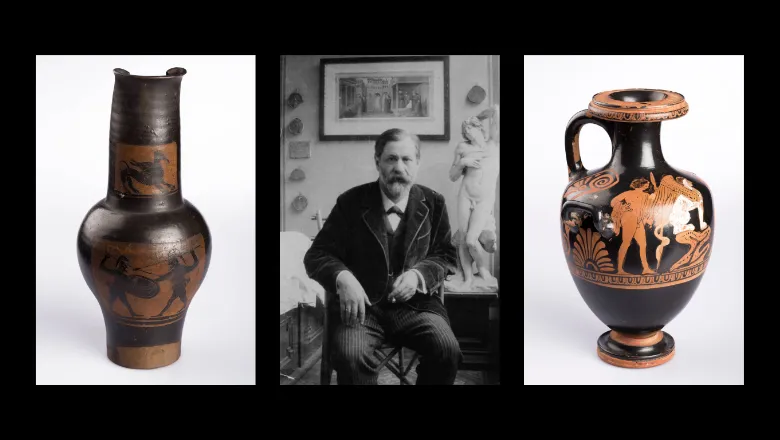Freud compared his exploration of the psyche to being an archaeologist, digging into our lost past. He was fascinated by the ancient world.
Daniel Orrells, Professor of Classics
19 January 2023
Classics Professor Daniel Orrells co-curates major Freud exhibition
A new major exhibition at Freud Museum London and accompanying digital archive bring rarely seen antiquities from Freud’s extensive collection into dialogue with his key theories

Freud’s Antiquity: Object, Idea, Desire, a new major exhibition at Freud Museum London with an accompanying digital archive, will demonstrate the crucial role of Freud's rarely seen, extensive collection of nearly 2,500 antiquities in his development of the concepts and methods of psychoanalysis.
Freud’s study in his home in Hampstead contains a vast array of items from, or inspired by, the ancient world. For the new exhibition, twenty-five key objects, books and prints, each normally hidden from view, will be offered for investigation at close range.
Co-curated by Professor Daniel Orrells from the Department of Classics at King’s College London, Freud’s Antiquity: Object, Idea, Desire is presented by the Freud Museum London in association with King’s, alongside University College London and University of Houston.
The antiquities that populated Freud’s consulting room in Vienna and London were not only physical evidence of a longstanding fascination for archaeology and the ancient world, but also active collaborators in the development of the concepts and methods of psychoanalysis.
Throughout his psychoanalytic writings, Freud repeatedly drew an analogy between the work of the psychoanalyst and that of the archaeologist. The psychoanalyst, in searching for the cause of a symptom, unearths forgotten memories and fantasies, just as the archaeologist, in searching for buried artefacts and hidden cities, digs into the soil.
By viewing Freud’s theories through the prism of his objects, the exhibition and its supporting archive will pose fundamental questions about how we search for meaning in the objects that surround us and expose the irresolvable tension between the material and the ideal that objects can open up.
His study is filled with nearly 2,500 Mediterranean antiquities he collected on his travels. But when you visit his house, these objects are hidden away in cabinets, invisible to the public eye. The exhibition reveals what we cannot see, digs deep into those secretive cabinets to explore how Freud's obsession with archaeology helped him formulate his scandalous ideas. It is the return of the repressed!
Daniel Orrells, Professor of Classics
The exhibition will contain a comprehensive digital archive, accessible through QR codes displayed in the exhibition, for people who want to discover more detailed analysis ‘under the surface’ of the exhibition.
Visit the exhibition
Freud’s Antiquity: Object, Idea, Desire at Freud Museum London
25 February 2023 - 16 July 2023
Wednesday - Sunday, 10.30am - 5pm
For more information about the exhibition, including opening times and ticket information, visit Freud Museum London website:
https://www.freud.org.uk/exhibitions/freuds-antiquity-object-idea-desire/

